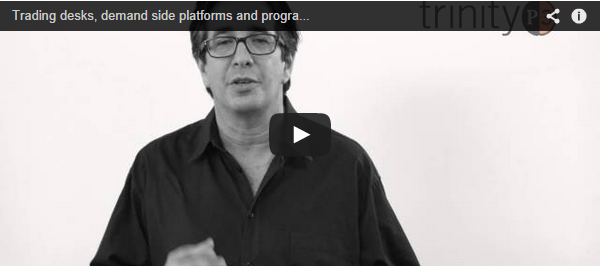Programatic buying, trading desks, ad exchanges, real time bidding, demand side platforms and the like feature heavily in the trade press and in marketing departments around the world because of issues including transparency in regards to cost and profits, data ownership issues and accountability on ad placement environments.
For marketers increasingly involved in this area (and that is anyone with a digital media budget), it is important to understand what it is and how this whole process works. In this video I explain the whole process in plain language to introduce the elements and concepts involved.
It is clearly useful, because since loading the video to YouTube, thousands of people have viewed it. If you find this useful too, please leave a comment or like it and check out some of the other videos I think are useful on this topic including: 200ms: The Life of a Programmatic RTB Ad Impression by Media Crossing, Display Advertising Basics (DSPs, RTB, Ad Exchanges, DMPs) a 20 minute video by Pete Kluge, the IAB: How an Ad is Served with Real Time Bidding (RTB) or Real Time Bidding 101 by AcuityAds.
Transcript:
What are demand side platforms, trading desks, real time bidding and programmatic buying?
If you are working in media, advertising and marketing I am sure you have heard of terms like demand side platforms, trading desks, real time bidding, programmatic buying and the like.
You have probably also heard there is quite a bit of controversy about it due to issues like transparency and quality control.
And like many, you are probably not completely sure what it all means.
Well this is not a dummies guide to digital media, but I think it is worthwhile trying to explain what this is all about in plain English.
So here we go.
Internet advertising
Digital or Internet advertising, like all advertising, is about getting your message to the right people, in the right place at the right time. The difference is that in most other media you plan and commit to placing your ad in a certain place, be it on television at a specific time in a specific program where you hope the audience will see it. Or in a magazine where you hope they will read and notice it.
But the Internet is different in that your ad only appears when the webpage the person is looking for is loaded on to their computer, or tablet or mobile and your ad is placed or “served” there.
Making sense so far?
It means that the same person could load the same webpage five times in a row and get five different ads and only one of them is yours.
This is real time. It is not like your ad is sitting on the Internet waiting for the right people to come along and see it. You have to go and find those people.
Now imagine how many webpages are being loaded into browsers on computers or mobiles phones or tablets every minute of every day. Billions.
There is so much opportunity to reach your audience on-line, because there is so much inventory available.
Demand side platforms
The inventory is owned by the site owners or publishers, who sell through any one of a number of ad exchanges. To manage and access transactions across multiple ad exchanges, they have developed demand side platforms, or DSPs, a system designed to give you access and facilitate these transactions.
Access to these DSPs are provided to the users, including agencies, media buyers or even the client through a trading desk. So the DSP is really just a way to access the inventory through a trading desk from an ad exchange.
Keeping up?
Real time bidding and programmatic buying
The transactions happen within the Ad Exchange in real time, giving rise to real time bidding or RTB, because they bid for the opportunities available when they appear. And when I say real time I mean it. This transaction happens in milliseconds.
There is no way this can be a manual process, which is why it is called programmatic buying, because the platforms and systems used, uses data on the online audience to optimise delivery, thereby getting the best deal on a trade by trade basis to deliver the required audience.
Sounds good, right?
So why are some advertisers unhappy with this?
There are a number of reasons:
The first is that because the transactions happen in a real time trading environment it is difficult to benchmark.
Second, this is compounded by the fact that the agencies are not always completely transparent. You see there is a dispute about both pricing and data ownership and this makes advertisers suspicious of what else is happening.
And last, but by no means least, there is a concern that with all of this automation ads could end up being served to inappropriate websites like pornography, gambling or perhaps an outlaw bikie gang where the content and association is damaging to the brand.
If you are interested or concerned about these issues and not sure who to talk with, talk to us at TrinityP3. We are not selling media, but we do provide our clients with understanding and peace of mind.




